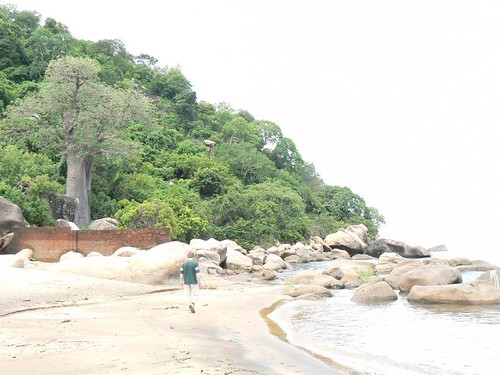The Baobab

Baobabs are popularly seen as vegetable elephants, the most bulky, contorted, awesome, antique masses of tree tissue on the planet. The greatest are believed to be 1,000 years old, but it's their surreal shapes as much as their presumed ages that have always marked them out. The Senegalese trees in Mimi Mollica's portraits seem to be chimeras, hybrids between plant, animal and rock. They're alabaster columns, lava streams, desert boulders, cave mouths. Their bark echoes the hide of the elephants to which they are so often compared, pouched and wrinkled and etched, ironically, with the gougings of tusks. When they're young, they inhabit a monde renversé, the flat, foreshortened topknot of branches looking for all the world like a root system.
No wonder baobabs were the subject of fascinated myths in West Africa. One is that, at the Creation, the animals were each given trees of their own. The hyena got the baobab - and was so appalled he turned it upside down. A related story tells that the primordial baobab was too beautiful for its own good, so the gods punished it by turning it topsy-turvy. In Senegal, villagers once buried their dead in the hollow trunks. In nearby Burkina Faso, the death of a baobab is commemorated by a full-dress communal wake. It's not that the trees are seen as gods or wreathed by taboos. They are accepted as members of the community, arboreal village elders.
Baobabs share many of the qualities of their human compatriots. They're citizens of the arid lands, frugal, resilient, inventive. The tree originated in Madagascar, where there are seven indigenous species; 10 million years ago, the seeds of one floated out into the Indian Ocean and arrived in Africa, from which beaching it spread across the continent. Others bobbed across the Pacific to Australia, where their descendants evolved into an eighth species.
The reason for the baobabs' immense girth and a physiognomy that can remind you of a pitcher, or a teapot, or a rather superior magnum of wine, is that they are filled to bursting with water. The soft wood of the trunk serves as a sponge, a living cistern sometimes 1,000 cubic metres in capacity; as a result, they are resistant to drought. They grow quickly and soon become hollow, at which point they may be dragooned into use as village reservoirs: a water tank inside a watery shell. Almost every part of the tree, except the spongy timber, is put to use. The fruit shells are rich in protein and used in Africa for animal food. In India (where the tree has been introduced) they make floats for fishing nets. The trunk can be debarked and used to make rope. Even the seed pulp is used for a drink that resembles lemon sherbet.
But the biggest and oldest baobabs become places. Their characterful bulk makes them landmarks, meeting points, shrines. One in South Africa has been turned into a pub. A famous "boab" in Australia, with the improbable shape of the pots in which missionaries were supposedly cooked, was used as a prison for Aborigines, then as a sacred burial site.
 Thomas Pakenham, in The Remarkable Baobab, deplores these vulgar "desecrations", but they seem no more disrespectful or unnatural than the burrowings of woodpeckers and badgers. Humans have anciently had intimate and affectionate relationships with huge trees. Not just because they so surpass us in size and longevity, but because they stir empathy. One of the awesome South African baobabs, the Hoedspruit giant, is a writhing mass more than 30m in circumference. It has horizontal trunks, immense supporting buttresses, huge fatty calluses. Its history is impenetrable. It may have been knocked down by an elephant in its youth, blown apart by storms, set on fire by honey-hunters. Yet it's still vivaciously alive, and growing back towards the light. All trees react positively to damage. They don't repair wounds, they transcend them, creating a new kind of tissue called "reaction wood". This is the sinewy material that edges scars, that supports wind-warped trunks as they begin their slow climb back to the vertical. It is nothing less than wooden muscle.
Thomas Pakenham, in The Remarkable Baobab, deplores these vulgar "desecrations", but they seem no more disrespectful or unnatural than the burrowings of woodpeckers and badgers. Humans have anciently had intimate and affectionate relationships with huge trees. Not just because they so surpass us in size and longevity, but because they stir empathy. One of the awesome South African baobabs, the Hoedspruit giant, is a writhing mass more than 30m in circumference. It has horizontal trunks, immense supporting buttresses, huge fatty calluses. Its history is impenetrable. It may have been knocked down by an elephant in its youth, blown apart by storms, set on fire by honey-hunters. Yet it's still vivaciously alive, and growing back towards the light. All trees react positively to damage. They don't repair wounds, they transcend them, creating a new kind of tissue called "reaction wood". This is the sinewy material that edges scars, that supports wind-warped trunks as they begin their slow climb back to the vertical. It is nothing less than wooden muscle.
We recognise this. In ancient baobab or beech we instinctively understand the tree's response to a challenge shared by all living things: of staying upright, holding the centre in a disorderly world.
* My photo of a Baobab tree in Lake Malawi


Comentários